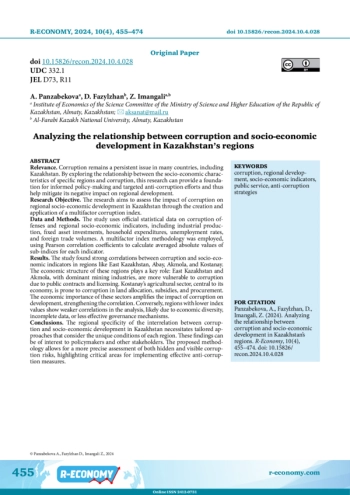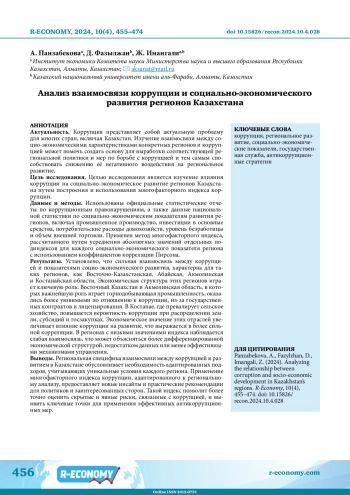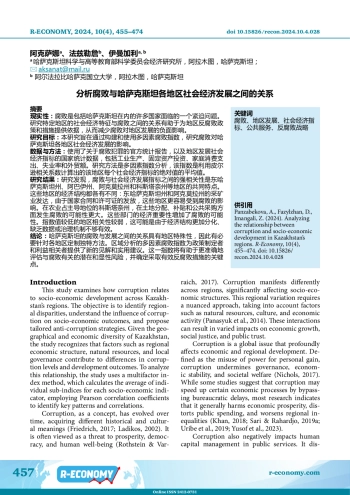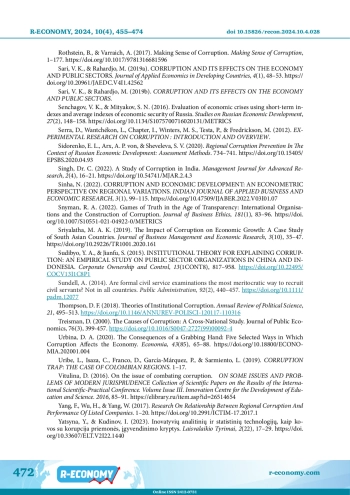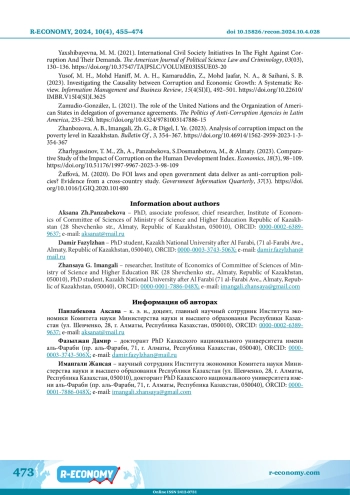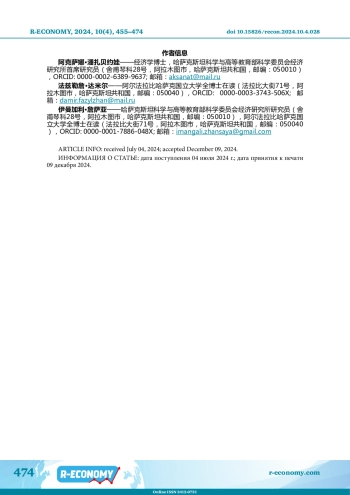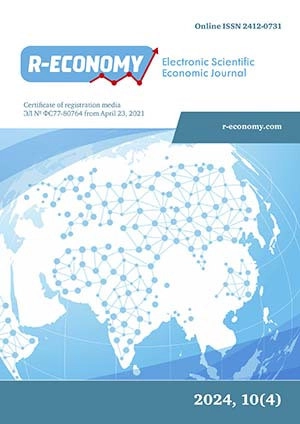Relevance. Corruption remains a persistent issue in many countries, including Kazakhstan. By exploring the relationship between the socio-economic characteristics of specific regions and corruption, this research can provide a foundation for informed policy-making and targeted anti-corruption efforts and thus help mitigate its negative impact on regional development. Research Objective. The research aims to assess the impact of corruption on regional socio-economic development in Kazakhstan through the creation and application of a multifactor corruption index. Data and Methods. The study uses official statistical data on corruption offenses and regional socio-economic indicators, including industrial production, fixed asset investments, household expenditures, unemployment rates, and foreign trade volumes. A multifactor index methodology was employed, using Pearson correlation coefficients to calculate averaged absolute values of sub-indices for each indicator. Results. The study found strong correlations between corruption and socio-economic indicators in regions like East Kazakhstan, Abay, Akmola, and Kostanay. The economic structure of these regions plays a key role: East Kazakhstan and Akmola, with dominant mining industries, are more vulnerable to corruption due to public contracts and licensing. Kostanay’s agricultural sector, central to its economy, is prone to corruption in land allocation, subsidies, and procurement. The economic importance of these sectors amplifies the impact of corruption on development, strengthening the correlation. Conversely, regions with lower index values show weaker correlations in the analysis, likely due to economic diversity, incomplete data, or less effective governance mechanisms. Conclusions. The regional specificity of the interrelation between corruption and socio-economic development in Kazakhstan necessitates tailored approaches that consider the unique conditions of each region. These findings can be of interest to policymakers and other stakeholders. The proposed methodology allows for a more precise assessment of both hidden and visible corruption risks, highlighting critical areas for implementing effective anti-corruption measures.
Идентификаторы и классификаторы
This study examines how corruption relates to socio-economic development across Kazakhstan’s regions. The objective is to identify regional disparities, understand the influence of corruption on socio-economic outcomes, and propose tailored anti-corruption strategies. Given the geographical and economic diversity of Kazakhstan, the study recognizes that factors such as regional economic structure, natural resources, and local governance contribute to differences in corruption levels and development outcomes. To analyze this relationship, the study uses a multifactor index method, which calculates the average of individual sub-indices for each socio-economic indicator, employing Pearson correlation coefficients to identify key patterns and correlations.
Список литературы
1. Abuova M. (2020). Corruption in Kazakhstan: and its impact on the economic development of the country. Bulletin of the L.N. Gumilyov Eurasian National University. Political Science. Regional Studies. Oriental Studies. Turkology Series., 133(4), 8-13. DOI: 10.32523/2616-6887/2020-133-4-8-13 EDN: TXYRWQ
2. Aguirre-Unceta R. (2024). Kazakhstan: extractive resources, governance and inclusive development. Journal of Social and Economic Development, 26(1), 235-257. DOI: 10.1007/S40847-023-00252-1/METRICS
3. Artemova E., Maksimenko A., Ohrimenko D. (2022). Application of machine learning methods in the classification of corruption related content in Russian-speaking and English-speaking Internet media. Sociology: Methodology, Methods, Mathematical Modeling (Sociology: 4M), 27(52), 131-157. DOI: 10.19181/4M.2021.52.5
4. Bajada C., Shashnov M. (2019). The effects of economic development and the evolution of social institutions on the level of corruption: comparing the Asia-Pacific with other regional blocs. Asia Pacific Business Review, 25(4), 470-500. DOI: 10.1080/13602381.2019.1589768
5. Besley T., Persson T. (2010). State capacity, conflict, and development. Econometrica, 78(1), 1-34. DOI: 10.3982/ECTA8073
6. Bowra A., Saeed G., Gorodensky, A., & Kohler, J. C. (2022). An exploration of anti-corruption and health in international organizations. PLoS ONE, 17(8 August). DOI: 10.1371/JOURNAL.PONE.0269203
7. Coetzee J. (2014). The impact of corruption on development.
8. Corrado G., Rossetti F. (2018). Public corruption: A study across regions in Italy. Journal of Policy Modeling, 40(6), 1126-1139. DOI: 10.1016/J.JPOLMOD.2018.01.001
9. Dahlström C., Lapuente V., Teorell J. (2012). The merit of meritocratization: Politics, bureaucracy, and the institutional deterrents of corruption. Political Research Quarterly, 65(3), 656-668. DOI: 10.1177/1065912911408109
10. Darusalam D., Said J., Omar N., Janssen M., Sohag K. (2019). The Diffusion of ICT for Corruption Detection in Open Government Data. Knowledge Engineering and Data Science, 2(1), 10. DOI: 10.17977/UM018V2I12019P10-18
11. Del Monte A., Papagni E. (2007). The Determinants of Corruption in Italy: Regional Panel Data Analysis. Criminology EJournal, 23(2), 379-396. DOI: 10.1016/J.EJPOLECO.2006.03.004
12. Denny D., Kazim E., Koshiyama A., Treleaven P., Dolga R. (2021). Anticorruption Techs to Face a Global Economy - Federated Learning, Open Data Catalogues, and “Blockchain”. Social Science Research Network. DOI: 10.2139/SSRN.3965030
13. Densumite S. (2023). Corruption and Economic Growth: An Empirical Study in 12 Countries. Asia Social Issues, e262107. DOI: 10.48048/ASI.2024.262107
14. Eshun J., Baah J. A. (2020). What Does Recent Survey Data Say About the Effect of Corruption on Poverty in Africa? Journal of Economics, Management and Trade, 1-13. DOI: 10.9734/jemt/2019/v25i630214
15. Fiorino N., Galli E., Petrarca I. (2012). Corruption and Growth: Evidence from the Italian regions. European Journal of Government and Economics (EJGE), 1(2), 126-144. DOI: 10.17979/EJGE.2012.1.2.4281
16. Fisman R., Gatti R. (2002). Decentralization and Corruption: Evidence Across Countries. Journal of Public Economics, 83(3), 325-345. DOI: 10.1016/S0047-2727(00)00158-4
17. Franco D., GARCIA-MARQUEZ P., Sarmiento L. (2019). CORRUPTION TRAP: THE CASE OF COLOMBIAN REGIONS.
18. Friedrich C. J. (2017). Corruption Concepts in Historical Perspective. Political Corruption: Concepts and Contexts: Third Edition, 15-24. DOI: 10.4324/9781315126647-2
19. Gillanders R. (2014). Corruption and Infrastructure at the Country and Regional Level. Journal of Development Studies, 50(6), 803-819. DOI: 10.1080/00220388.2013.858126
20. Gupta S., Davoodi H., Alonso-Terme R. (2002). Does corruption affect income inequality and poverty? Economics of Governance 2002 3:1, 3(1), 23-45. DOI: 10.1007/S101010100039
21. Hawken A., Munck G. L. (2006). Measuring Corruption: A Critical Assessment and a Proposal.
22. Hellmann O. (2015). The Institutionalisation of Corruption: The Neglected Role of Power.
23. Heywood P. M., Rose J. (2014). “Close but no Cigar”: the measurement of corruption*. Journal of Public Policy, 34(3), 507-529. DOI: 10.1017/S0143814X14000099
24. Hlatshwayo S., Oeking A., Corvino D., Shukla A., Leigh L. (2018). The Measurement and Macro-Relevance of Corruption: A Big Data Approach. The International Distribution of News: The Associated Press, Press Association, and Reuters, 1848-1947, 1-256. DOI: 10.1017/CBO9781139522489
25. Hulstijn J., Darusalam D., Janssen M. (2017). Open Data for Accountability in the Fight Against Corruption. CARe-MAS@PRIMA.
26. Johnston M. (2017). The New Corruption Rankings: Implications for Analysis and Reform. Political Corruption: Concepts and Contexts: Third Edition, 865-884. DOI: 10.4324/9781315126647-69
27. Kaufmann D., Kraay A., Mastruzzi M. (2009). Governance Matters VIII: Aggregate and Individual Governance Indicators, 1996-2008. World Bank Policy Research Working Paper No. 4978. The World Bank.
28. Khan M. (2018). Economic Research of Corruption: Its Consequences. Research on Humanities and Social Sciences, 8(11).
29. Ladikos A. (2002). The ancient concept of corruption: a platonic interpretation. Acta Criminologica: Southern African Journal of Criminology.
30. Lambsdorff J. (2003). How corruption affects economic development.
31. Lambsdorff J. (2005). Consequences and causes of corruption: What do we know from a cross-section of countries?
32. Li J., Chen W. H., Xu Q., Shah N., MacKey T. (2019). Leveraging Big Data to Identify Corruption as an SDG Goal 16 Humanitarian Technology. IEEE Global Humanitarian Technology Conference. DOI: 10.1109/GHTC46095.2019.9033129
33. Lima M. S. M., Delen D. (2020). Predicting and explaining corruption across countries: A machine learning approach. Government Information Quarterly, 37(1). DOI: 10.1016/J.GIQ.2019.101407 EDN: XTXCLV
34. Malaj V., Firza N. (2023). The Impact of Corruption on Migration: Evidence from the Western Balkans. Migration Letters, 20(8), 896-907. DOI: 10.59670/ml.v20i8.5627 EDN: OZLRWB
35. Mamitova Z. A., Kumarbekkyzy Z., Tapenova A. R., Mahanov T. G. (2016). On Certain Aspects of Acts of Corruption Countermeasures. International Journal of Environmental and Science Education, 618.
36. Mauro P. (1995). Corruption and Growth. The Quarterly Journal of Economics, 110(3), 681-712. DOI: 10.2307/2946696 EDN: CBQYBF
37. Moniri S. M., Belghadr B., Ataei S. V., Safari Z., Zolali A. M. (2013). The Study of Factors causing Corruption in Governmental and Non-Governmental Organizations.
38. Mukhamediyev B., Bimendiyeva L., Dauliyeva G., Temerbulatova Z. (2023). Unrest in Kazakhstan: Economic background and causes. Cogent Economics & Finance, 11. DOI: 10.1080/23322039.2023.2263305
39. Nazarychev D., Sigurova O. Yu. (2022). Classification of indicators of anti-corruption monitoringof the regions of the Russian Federation. The Economy under Guard. DOI: 10.36511/2588-0071-2022-3-73-80
40. Neeman Z., Paserman M. D., Simhon A. (2003). Corruption and Openness. The B.E. Journal of Economic Analysis & Policy, 8(1). DOI: 10.2202/1935-1682.2013 EDN: MIDHXV
41. Newhouse M., Theory F., Thompson D. F. (2013). Institutional Corruption: A Fiduciary Theory. Political Economy - Development: Underdevelopment & Poverty EJournal. DOI: 10.2139/SSRN.2335619
42. Nichols P. M. (2017). What is Organizational Corruption? The Handbook of Business and Corruption: Cross-Sectoral Experiences, 3-24. DOI: 10.1108/978-1-78635-445-720161001/FULL/XML
43. Nurkey A., Mukasheva A., Yedilkhan D. (2022). Models and methods of digital mechanisms in anti-corruption, their advantages and disadvantages, and applications. IOP Conference Series: Materials Science and Engineering, 1216(1), 012015. DOI: 10.1088/1757-899X/1216/1/012015 EDN: UYALBW
44. Oliveira G. (2014). Institutional Corruption as a Problem of Institutional Design: A General Framework. Political Economy - Development: Underdevelopment & Poverty EJournal. DOI: 10.2139/SSRN.2423554
45. Panasyuk, M. V., Pudovik, E. M., & Malganova, I. G. (2014). Modified index method in scenarios of regional socio-economic development. Mediterranean Journal of Social Sciences, 5(18 SPEC. ISSUE), 331-334. DOI: 10.5901/mjss.2014.v5n18p331 EDN: UEXUPR
46. Panzabekova A., Irina T., Zhanbozova A. (2021). Measuring the institutional environment of corruption in Kazakhstan based on international indices. Adam Alemi, 88(2), 66-80. DOI: 10.48010/2021.2/1999-5849.07
47. Pillay S. (2014). An Institutional Theory Perspective on Corruption. Development Corruption in South Africa, 77-104. DOI: 10.1057/9781137383501_4
48. Pillay S., Kluvers R. (2014). An Institutional Theory Perspective on Corruption: The Case of a Developing Democracy. New Institutional Economics EJournal, 30(1), 95-119. DOI: 10.1111/FAAM.12029
49. Prihatmanto H. N., Munajat M. D. E., Irawati I. (2023). Detecting the corruption pattern and measuring the corruption detection pace at the Indonesian village level. Jurnal Tata Kelola Dan Akuntabilitas Keuangan Negara, 9(2), 289-308. DOI: 10.28986/JTAKEN.V9I2.1361 EDN: BNEYFG
50. Prorokov A. (2015). THE DIRECTIONS OF ANTI-CORRUPTION POLICY IN THE MOSCOW REGION. Bulletin of the Moskow State Regional University, 4, 13-21. DOI: 10.18384/2310-6646-2015-4-13-21 EDN: VEAIPV
51. Rose-Ackerman S. (2011). Anti-Corruption Policy: Can International Actors Play a Constructive Role? Public International Law: Organizations EJournal.
52. Rothstein B., Varraich A. (2017). Making Sense of Corruption. Making Sense of Corruption, 1-177. DOI: 10.1017/9781316681596
53. Sari V. K., Rahardjo M. (2019a). CORRUPTION AND ITS EFFECTS ON THE ECONOMY AND PUBLIC SECTORS. Journal of Applied Economics in Developing Countries, 4(1), 48-53. DOI: 10.20961/JAEDC.V4I1.42562
54. Sari V. K., Rahardjo M. (2019b). CORRUPTION AND ITS EFFECTS ON THE ECONOMYAND PUBLIC SECTORS.
55. Senchagov V. K., Mityakov S. N. (2016). Evaluation of economic crises using short-term indexes and average indexes of economic security of Russia. Studies on Russian Economic Development, 27(2), 148-158. DOI: 10.1134/S1075700716020131/METRICS EDN: ULPKJE
56. Serra D., Wantchékon L., Chapter I., Winters M. S., Testa P., Fredrickson M. (2012). EXPERIMENTAL RESEARCH ON CORRUPTION: INTRODUCTION AND OVERVIEW.
57. Sidorenko E. L., Arx A. P. von, Sheveleva S. V. (2020). Regional Corruption Prevention In The Context of Russian Economic Development: Assessment Methods. 734-741. DOI: 10.15405/EPSBS.2020.04.93
58. Singh Dr. C. (2022). A Study of Corruption in India. Management Journal for Advanced Research, 2(4), 16-21. DOI: 10.54741/MJAR.2.4.3
59. Sinha N. (2022). CORRUPTION AND ECONOMIC DEVELOPMENT: AN ECONOMETRIC PERSPECTIVE ON REGIONAL VARIATIONS. INDIAN JOURNAL OF APPLIED BUSINESS AND ECONOMIC RESEARCH, 3(1), 99-115. DOI: 10.47509/IJABER.2022.V03I01.07
60. Snyman R. A. (2022). Games of Truth in the Age of Transparency: International Organisations and the Construction of Corruption. Journal of Business Ethics, 181(1), 83-96. DOI: 10.1007/S10551-021-04922-0/METRICS EDN: JPECDQ
61. Sriyalatha M. A. K. (2019). The Impact of Corruption on Economic Growth: A Case Study of South Asian Countries. Journal of Business Management and Economic Research, 3(10), 35-47. DOI: 10.29226/TR1001.2020.161
62. Sudibyo Y. A., Jianfu,S. (2015). INSTITUTIONAL THEORY FOR EXPLAINING CORRUPTION: AN EMPIRICAL STUDY ON PUBLIC SECTOR ORGANIZATIONS IN CHINA AND INDONESIA. Corporate Ownership and Control, 13(1CONT8), 817-958. DOI: 10.22495/COCV13I1C8P1
63. Sundell A. (2014). Are formal civil service examinations the most meritocratic way to recruit civil servants? Not in all countries. Public Administration, 92(2), 440-457. DOI: 10.1111/padm.12077
64. Thompson D. F. (2018). Theories of Institutional Corruption. Annual Review of Political Science, 21, 495-513. DOI: 10.1146/ANNUREV-POLISCI-120117-110316
65. Treisman D. (2000). The Causes of Corruption: A Cross-National Study. Journal of Public Economics, 76(3), 399-457. DOI: 10.1016/S0047-2727(99)00092-4 EDN: DYSSXV
66. Urbina D. A. (2020). The Consequences of a Grabbing Hand: Five Selected Ways in Which Corruption Affects the Economy. Economia, 43(85), 65-88. DOI: 10.18800/ECONOMIA.202001.004 EDN: XDCCUR
67. Uribe L., Isaza C., Franco D., García-Márquez P., Sarmiento L. (2019). CORRUPTION TRAP: THE CASE OF COLOMBIAN REGIONS. 1-17.
68. Vitulina D. (2016). On the issue of combating corruption. ON SOME ISSUES AND PROBLEMS OF MODERN JURISPRUDENCE Collection of Scientific Papers on the Results of the International Scientific-Practical Conference. Volume Issue III. Innovation Centre for the Development of Education and Science. 2016, 85-91. https://elibrary.ru/item.asp?id=26514654.
69. Yang F., Wu H., Yan, W. (2017). Research On Relationship Between Regional Corruption And Performance Of Listed Companies. 1-20. DOI: 10.2991/ICTIM-17.2017.1
70. Yatsyna Y., Kudinov I. (2023). Inovatyvių analitinių ir statistinių technologijų, kaip kovos su korupcija priemonės, įgyvendinimo kryptys. Laisvalaikio Tyrimai, 2(22), 17-29. DOI: 10.33607/ELT.V2I22.1440 EDN: MYGPJT
71. Yaxshibayevna M. M. (2021). International Civil Society Initiatives In The Fight Against Corruption And Their Demands. The American Journal of Political Science Law and Criminology, 03(03), 130-136. DOI: 10.37547/TAJPSLC/VOLUME03ISSUE03-20 EDN: LZGJWV
72. Yusof M. H., Mohd Haniff M. A. H., Kamaruddin Z., Mohd Jaafar N. A., Saihani S. B. (2023). Investigating the Causality between Corruption and Economic Growth: A Systematic Review. Information Management and Business Review, 15(4(SI)I), 492-501. DOI: 10.22610/IMBR.V15I4(SI)I.3625
73. Zamudio-González L. (2021). The role of the United Nations and the Organization of American States in delegation of governance agreements. The Politics of Anti-Corruption Agencies in Latin America, 235-250. DOI: 10.4324/9781003147886-15
74. Zhanbozova, A. B., Imangali Zh. G., Digel I. Ye. (2023). Analysis of corruption impact on the poverty level in Kazakhstan. Bulletin Of, 3, 354-367. DOI: 10.46914/1562-2959-2023-1-3-354-367
75. Zharlygassinov T. M., Zh. A. Panzabekova, S. Dosmanbetova, M. Almaty. (2023). Comparative Study of the Impact of Corruption on the Human Development Index. Economics, 18(3), 98-109. DOI: 10.51176/1997-9967-2023-3-98-109
76. Žuffová M. (2020). Do FOI laws and open government data deliver as anti-corruption policies? Evidence from a cross-country study. Government Information Quarterly, 37(3). DOI: 10.1016/J.GIQ.2020.101480 EDN: TEOZQD
Выпуск
Другие статьи выпуска
Relevance The growing importance of creative industries in Russia’s economy underscores the need for effective management strategies to support the reindustrialization of second-tier cities, with a focus on socio-economic growth and the preservation of local identity. Research Objective The article aims to identify key factors that influence the development and implementation of creative reindustrialization strategies in second-tier cities. Data and Methods Using econometric modeling, the study analyzed data from 50 industrial cities in Sverdlovsk and Chelyabinsk regions (2010-2024), sourced from the Federal State Statistics Service, the Ministry of Construction, Housing and Utilities, and the Presidential Grant Foundation. Results. The study identified key factors contributing to the growth of creative industries, including the expansion of creative sector companies, proximity to regional centers, increased grant applications, the presence of manufacturing enterprises, growth in local government revenue, and the development of new housing. A comprehensive set of government support measures was proposed, encompassing infrastructure development, financial assistance, educational initiatives, informational resources, and regulatory improvements. Conclusions Essential government support to creative industries should include infrastructure development, simplified administrative procedures, tax incentives, institutional and legislative backing, and export promotion. Other support measures can be tailored to the chosen management strategy and regional needs, resulting in the creation of a flexible system centered around local identity.
Relevance. Technological sovereignty in the national economy cannot be achieved without a clear understanding of the state of regional industries, particularly their level of technological maturity. This crucial factor drives investment decisions and shapes regional development strategies. However, existing methods for assessing technological development often fail to account for industries’ reliance on foreign technologies and services. Research Objective. The study explores the concept of technological maturity in the context of managing regional industrial development, focusing on the case of regional industries in Russia. Data and Methods. To evaluate the technological maturity of regional industries, we propose an index derived from normalizing key indicators that capture the critical aspects of technological maturity. The normalized indicators are aggregated using the arithmetic mean. Correlation analysis was employed to identify factors influencing technological development. The study is based on official statistics from the Federal State Statistics Service (Rosstat) for 2022. Results. Technological maturity indices are calculated for Russian regions, identifying both strengths and weaknesses. Only nine regions have achieved a medium level of technological maturity, while most remain at low levels. Additionally, many regions leading in terms of technology are highly reliant on imported technologies and services, with minimal exports of domestically developed technologies. These results highlight the need for policy measures tailored to regions’ varying needs and levels of technological maturity. Conclusions The concept of technological maturity provides a strategic framework for regional industrial development that can enhance national economic competitiveness through both embracing modern technologies and ensuring technological independence. The technological maturity index provides a valuable tool for tracking key indicators of technological sovereignty in domestic industries and identifying investment priorities to strengthen it.
Relevance. Russia is currently facing sanctions, which have had significant economic and social consequences. These crises have revealed vulnerabilities in the socio-economic system, highlighting the importance of studying them to better address current challenges and mitigate future risks. Objective. The study aims to identify the vulnerabilities in particular aspects of sustainable development across Russia’s regions during the crises of the past 15 years. Data and methods. The study draws on data from the Federal Statistical Service (Rosstat) to calculate a sustainable development index for regions, which tracks the impact of crises on their economic, social, and environmental sustainability. The index is constructed using a classical method, comprising three averaged sub-indices, each representing one of the three components of sustainable development. A higher index value indicates greater sustainability, with the impact of crises varying across regions. Results. During the 2014 crisis, regions specializing in export-oriented industries or those with a significant share of foreign capital in their economies were hit the hardest. Socially, the most vulnerable regions were those along the Chinese border in the Far East, which were impacted by trade restrictions. The 2020 pandemic had economic effects on nearly all regions, with cities of over a million people and their agglomerations suffering the most due to the abrupt suspension of the tertiary sector. The social sphere responds most quickly to crises, while the environmental component is more inert but shows a negative trend despite the crises. Conclusions. For regions with underdeveloped and monocentric economies, support measures should focus on diversifying industries, particularly those aimed at mass consumption. In coal-mining regions, it’s important to develop service sectors related to the industry during stable periods. For the Far Eastern regions, the main support measure is to stimulate industries geared towards meeting Chinese demand.
Relevance. Inter-municipal cooperation is an effective tool for addressing resource deficits faced by municipalities, and its importance has grown in today’s context of socio-economic instability. However, the success of such cooperation largely depends on a careful selection of partners, which raises the question of how the strength of ties between municipalities impacts their ability to collaborate effectively. Research objective. The aim of this study is to explore how the spatial characteristics of interdependence between municipalities influence their interactions and cooperation. Data and methods. The research draws on official statistical data from Russia’s Federal State Statistics Service (Rosstat), as well as information from investment passports and municipal socio-economic development strategies. The study employs spatial correlation methods, cartographic analysis, and general research techniques, including analysis and synthesis. Results. The inter-municipal relationships in Sverdlovsk Region are highly uneven, with significant disparities in the level of involvement across different areas. These relationships are predominantly concentrated around the region’s administrative center and its neighboring municipalities, while the northern and eastern parts exhibit the weakest connectivity. Municipalities in the Ekaterinburg urban agglomeration are the most active participants in joint projects, whereas those in the southwestern part of the region show less involvement. The northern and eastern areas, in particular, demonstrate minimal engagement in forming partnerships with other municipalities, highlighting a stark regional imbalance. Conclusions. The study confirms a strong link between the interdependence of municipalities and the extent of their cooperation. Factors such as territorial and socio-economic proximity play a key role, but additional drivers, such as national or regional policies, also significantly influence inter-municipal collaboration. Interestingly, a lack of resources among potential partners does not appear to impede cooperation.
Relevance. The well-being of citizens is a key focus of national policies worldwide. Kazakhstan, however, is characterized by significant regional disparities in social well-being, which necessitates targeted programs and investments to improve conditions in less developed areas. Research Objective. This study aims to develop a national adaptive social well-being index to evaluate and spatially map the regions of Kazakhstan. Data and Methods. The methodology included identifying indicators through a literature review and regional data, conducting an expert survey to weight them, and creating a social well-being index. A spatial analysis was then used to calculate the index for each region. Results. The social well-being index shows significant disparities across regions. Astana, Almaty, and Atyrau demonstrate strong social welfare, driven by economic growth and advanced social infrastructure. In contrast, Karaganda, Pavlodar, and Shymkent show lower social welfare, highlighting the need for targeted interventions and investments. Conclusion. The findings offer valuable insights for policymakers to design strategies for sustainable socioeconomic growth in Kazakhstan. The proposed index can help national and regional authorities monitor social well-being.
Relevance. The global imperative for adopting a low-carbon economy resonates worldwide, yet comprehensive assessments specific to the Russian economy remain scant. This is especially important considering the significant differences in the level of transition to sustainable development among Russian regions. Research Objective. This study aims to introduce a robust methodology for evaluating and analyzing the international trade of low-carbon goods (LCGs) across various Russian regions and assessing its effects on fuel combustion emissions. Data and Methods. Data on LCGs trade were obtained from the Federal Customs Service of Russia. In conjunction, datasets from Rosstat and the Central Bank of Russia were incorporated for comprehensive econometric modeling. The analytical framework employed Tobit and quantile regressions. Results. The study uncovers significant disparities among Russian regions regarding the intensity of low-carbon goods exports and imports. This variation highlights the diverse competencies in LCGs production, as well as differing ecological agendas and consumption patterns across regions. Additionally, the research demonstrates that, although the widespread adoption of advanced production technologies is positively correlated with increased fuel combustion emissions, a U-shaped relationship exists where higher LCGs exports are associated with reductions in fuel combustion emissions across Russian regions to a certain degree. Conclusions. This research highlights important implications for both federal and regional industrial and environmental policies. It advocates for the development of targeted incentives that encourage the adoption of low-carbon goods (LCGs) and advanced technologies. By doing so, policymakers can effectively promote sustainable development tailored to the unique needs and conditions of various regions, thereby fostering ecological resilience and economic growth across diverse regional landscapes.
Статистика статьи
Статистика просмотров за 2025 год.
Издательство
- Издательство
- УрФУ
- Регион
- Россия, Екатеринбург
- Почтовый адрес
- 620002, Свердловская область, г. Екатеринбург, ул. Мира, д. 19
- Юр. адрес
- 620002, Свердловская область, г. Екатеринбург, ул. Мира, д. 19
- ФИО
- Кокшаров Виктор Анатольевич (Ректор)
- E-mail адрес
- rector@urfu.ru
- Контактный телефон
- +7 (343) 3754507
- Сайт
- https://urfu.ru/ru
